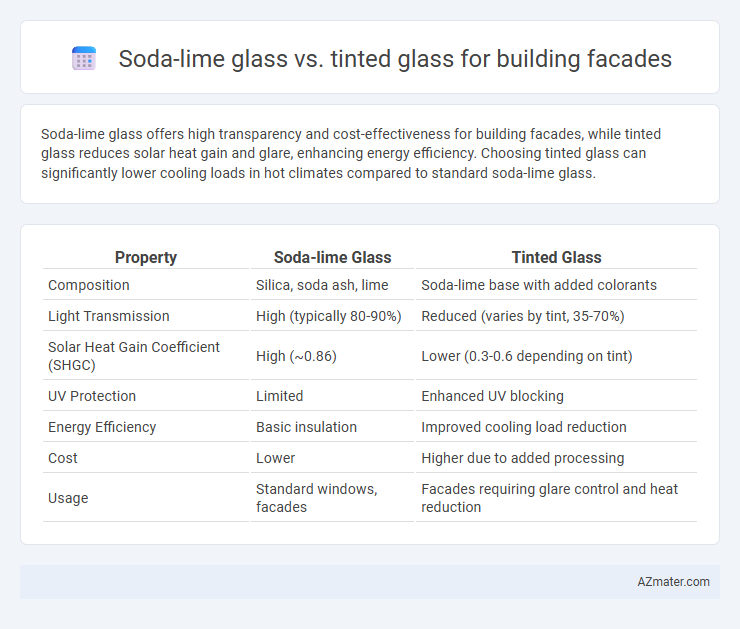Soda-lime glass offers high transparency and cost-effectiveness for building facades, while tinted glass reduces solar heat gain and glare, enhancing energy efficiency. Choosing tinted glass can significantly lower cooling loads in hot climates compared to standard soda-lime glass.
Table of Comparison
| Property | Soda-lime Glass | Tinted Glass |
|---|---|---|
| Composition | Silica, soda ash, lime | Soda-lime base with added colorants |
| Light Transmission | High (typically 80-90%) | Reduced (varies by tint, 35-70%) |
| Solar Heat Gain Coefficient (SHGC) | High (~0.86) | Lower (0.3-0.6 depending on tint) |
| UV Protection | Limited | Enhanced UV blocking |
| Energy Efficiency | Basic insulation | Improved cooling load reduction |
| Cost | Lower | Higher due to added processing |
| Usage | Standard windows, facades | Facades requiring glare control and heat reduction |
Introduction to Glass Facades in Modern Architecture
Soda-lime glass, widely used in building facades, offers affordability and excellent clarity, making it a popular choice for modern architectural designs focused on maximizing natural light. Tinted glass enhances energy efficiency by reducing solar heat gain and glare, contributing to sustainable building practices and occupant comfort. Both materials play crucial roles in contemporary glass facade construction, balancing aesthetics, functionality, and environmental performance.
What is Soda-Lime Glass?
Soda-lime glass is the most common type of glass used in building facades, composed primarily of silica, soda (sodium oxide), and lime (calcium oxide), which provide durability and clarity. It offers excellent transparency and is cost-effective, making it ideal for standard architectural applications. Unlike tinted glass, soda-lime glass does not reduce solar heat gain or glare, but it can be coated or treated to enhance energy efficiency.
Understanding Tinted Glass Technology
Tinted glass technology involves the infusion of metal oxides such as iron, copper, or selenium into the glass matrix, which reduces solar heat gain and minimizes glare while maintaining natural light transmission. Unlike soda-lime glass, which primarily serves as a basic transparent substrate, tinted glass enhances building energy efficiency by cutting UV and infrared radiation, thereby decreasing cooling loads. This technology offers architectural aesthetics and improved indoor comfort, making it a preferred choice for modern building facades that require both performance and design integration.
Aesthetic Differences: Soda-Lime vs Tinted Glass
Soda-lime glass has a clear, neutral appearance that allows natural light to pass through with minimal color distortion, offering a bright and transparent facade ideal for modern architectural designs. Tinted glass incorporates metal oxides or other additives, providing color hues ranging from bronze to gray, which reduces glare and enhances visual privacy while contributing to a more distinctive and sophisticated building exterior. The choice between soda-lime and tinted glass influences the overall aesthetic by balancing transparency and color impact, shaping the building's visual appeal and its interaction with daylight.
Light Transmission and Glare Control
Soda-lime glass typically offers high light transmission, allowing natural daylight to penetrate interiors effectively, but may result in increased glare, impacting occupant comfort. Tinted glass reduces light transmission by selectively filtering sunlight, significantly enhancing glare control and minimizing heat gain, which improves energy efficiency in building facades. Choosing between soda-lime and tinted glass depends on balancing desired daylight levels with glare mitigation requirements for optimal occupant comfort and visual performance.
Thermal Performance and Energy Efficiency
Soda-lime glass offers moderate insulation but allows significant solar heat gain, resulting in higher cooling loads compared to tinted glass. Tinted glass reduces visible light and solar heat transmission by absorbing and reflecting infrared radiation, enhancing thermal performance and lowering energy consumption for air conditioning. Buildings with tinted facades benefit from improved energy efficiency and occupant comfort due to decreased reliance on HVAC systems during hot weather.
Cost Considerations for Facade Projects
Soda-lime glass offers a cost-effective solution for building facades due to its widespread availability and lower manufacturing expenses compared to tinted glass. Tinted glass, while typically more expensive upfront, provides benefits such as reduced solar heat gain and glare, potentially lowering cooling costs over the building's lifespan. Evaluating initial investment against long-term energy savings is crucial for budget planning in facade projects.
Durability and Maintenance Needs
Soda-lime glass offers moderate durability with susceptibility to scratches and weathering, requiring regular cleaning to maintain clarity in building facades. Tinted glass provides enhanced durability by reducing solar heat and UV exposure, which minimizes wear and maintenance frequency. Maintenance needs for tinted glass are lower due to its ability to resist dirt buildup and fading compared to soda-lime glass.
Environmental Impact and Sustainability
Soda-lime glass, widely used in building facades, offers high recyclability and energy efficiency due to its common production methods and composition primarily of silica, sodium oxide, and calcium oxide. Tinted glass enhances solar control by reducing heat gain and UV radiation, thus lowering cooling energy consumption and improving building sustainability in hot climates. Both glass types contribute to environmental sustainability through their durability and potential for recycling, but tinted glass provides additional environmental benefits by reducing reliance on artificial cooling systems.
Choosing the Right Glass: Key Factors for Facade Design
Soda-lime glass is a cost-effective option with high clarity and good strength, making it suitable for standard building facades where natural light transmission is prioritized. Tinted glass provides enhanced solar control by reducing heat gain and glare, which improves energy efficiency and occupant comfort in facades exposed to intense sunlight. Selecting the right glass involves balancing factors such as thermal performance, daylighting needs, aesthetic preferences, and budget constraints to optimize facade functionality and building performance.

Infographic: Soda-lime glass vs Tinted glass for Building facade
 azmater.com
azmater.com